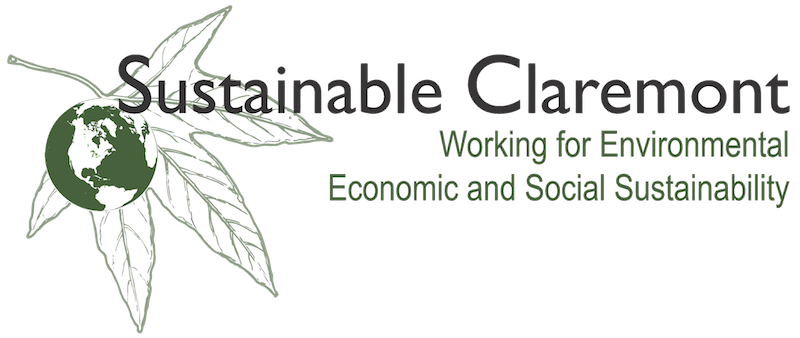Sustainable Claremont, a local grassroots organization dedicated to reminding us that sustainability should always be a factor as decisions are made and actions performed, recently held its second annual meeting. Sue Schenk [Biology at Joint Sciences] and Freeman Allen [retired Chemistry at Pomona College] serve as co-chairs of the organization. Freeman, who had worked with Mary Nichols, Director of California’s Air Resources Board [ARB], invited her to come to Claremont to give us an insider’s view of progress made and challenges facing those concerned about air quality and climate change in California. We can remember a time when we could not see our local mountains during the summer, but the air is cleaner now. It is tempting to think that we have resolved air quality issues and can go on to other things. Anyone who heard Mary Nichols address a large local audience at Padua Theatre earlier this month understands that our air quality problems are far from resolved.
Director Nichols reminded us that we live in a pollution hot spot. She cited a study that shows our air quality will be getting worse, not better, as temperature rises — if we don’t do something about climate change and global warming. As the temperature goes up, air quality will come down, and ground level ozone will rise. By mid-century, we can expect to experience about 30 high ozone [bad air] days a year, in addition to the other effects of increasing temperatures. Too much fuel combustion in the wrong places is responsible for ground and air pollution. Too much worldwide is causing global warming and climate change. We urgently need to find ways to improve. AB 32, the California Global Warming Solutions Act, is one step in trying to deal with the environmental problems we face. It would provide incentives and standards to taper back greenhouse gas levels to 1990 levels by 2020 – about 15%. About half of the measures needed have already been adopted. A further aim is to achieve about an 80% reduction in emissions of greenhouse gases by 2050. We need to switch from fossil fuels to renewables as seamlessly as possible. The way vehicle standards were adopted in the 1970’s provides a model. The switch to cleaner, more fuel-efficient vehicles was made faster than the manufacturers wanted to go. It worked.
President Obama ordered the federal EPA [Environmental Protection Agency] to approve California standards and said they should be phased in throughout the nation as a whole so that 2017 to 2025 cars meet the new standards. Big diesels also need, and their owners want, new standards to help them compete at the international level. Fuel economy and air quality standards go hand-in-hand; a 3%-6% improvement in fuel economy per year is possible. ARB will adopt new standards next year and will be pushing the US to recognize California as a partner. The public has proved there is a market; that’s progress. Light but still powerful cars, a hybrid mix that gets 60 mpg, will be common.
AB 32 helped bring this about. California and the 13 other states that adopted our standards have made a difference. Clearly, change needn’t depend on Congress. California ranks third in the world in fuel consumption, following the US as a whole and China. The metric is carbon. The market can design the mix. What really got the attention of Tesoro and Valero, the large oil companies, and led them to sponsor Proposition 23 [to try to overturn AB32] was the requirement that by 2020 23% of energy come from renewables, excluding large hydroelectric generation.
The brightest economic spot in the state is clean technology, reported Director Nichols. Last year, it amounted to about $2 billion [that’s about 60% of clean technology investment in North America coming to our one state]. The global research and consulting firm Clean Technology Group forecasts a $10 billion market for California by 2010, growing to almost $80 billion by 2020. Companies are moving to California to take advantage of our clean energy policies and markets. Legislators were more prescient than they knew when they passed AB 32.
Despite economic challenges, people support environmental investments. Energy efficiencies, car efficiencies [catalytic converters and much else], gave us the foundation for environmental improvements. California has shown leadership in a most significant area. In Director Nichol’s view, it is important to keep AB 32. Delaying its implementation even one year would be disruptive. Popular support for change is deep and long, but we mustn’t underestimate the scope of the problem. It is too late to avoid some of the worst impacts of climate change, but we can make a difference. [For example, we must protect forests. Denmark gave money to Brazil to save trees.] California needs to look at a mix of strategies; there is much low hanging fruit. In some areas [e.g., power storage] we need breakthroughs. We need to reconfigure power grids so that they are smarter. It will take investment and commitment.
Change is not something we, as a race, generally embrace, observed Director Nichols. We are in the midst of a transition comparable to the industrial revolution. There will be winners and losers, now as there were then. Changing the energy mix of the whole state is a gigantic job, and when they gave the ARB that job they didn’t budget for higher up-front costs.
Nonetheless, California has a lot of capacity. Cities have a variety of motivations to change—congestion, for one. The building industry is often ahead in its use of materials and techniques. The education system has significant resources. Getting people together and getting them to cooperate is what is important—difficult but worth the effort. Noting that not many communities had made a commitment to alter behavior, Director Nichols praised Claremont for deciding to infuse a sustainability ethic into the way the city does business.
Demystifying Sustainability is an initiative of Sustainable Claremont (sustainableclaremont.org).
